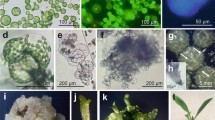Abstract
Plants of Solanum melongena were propagated under in vitro conditions (27°C, 12h/day illumination at 62 μEm-2s-1, 60% humidity) by subculture of terminal and lateral cuttings on MS medium +20 gl-1 sucrose + Morel and Wetmore vitamins at 1/8 strength and 7 gl-1 agar. Lamina, petioles and stems of 3-week-old cuttings were used as sources of protoplasts. The best mean yield of protoplasts was obtained from the lamina with 9,030×103 protoplasts per gram of tissue. Petioles and stems yielded respectively 3,144×103 and 1,220.4×103 protoplasts per gram of tissue. first division of petiole and stem protoplasts occurred within 48 h, while lamina protoplasts underwent division after 3–4 days of culture in KM8p medium +2,4-D(0.2 gl-1) + zeatin (0.5 mgl-1) + NAA (1 mgl-1) and 0.35M glucose as osmoticum. The highest percentage of dividing cells was obtained from petiole material, estimated at 33.4% after 7 days, compared to 23.8% and 19.4% respectively for stem and lamina protoplasts. When BAP replaced zeatin in KM8p, the division percentage of lamina protoplasts was reduced to 10–15%. When transferred to regeneration medium, all calli derived from KM8p + zeatin formed deep-green spots identified as embryo-like structures, while only few calli from KM8p + BAP underwent shoot organogenesis without formation of green spots. Some of embryo-like structure developed into plantlets with a frequency of 1–2 plantlets per callus especially on MS medium + zeatin (4 mgl-1) + IAA (0.2 mgl-1). Maintaining protoplast-derived calli on MS + BAP (0.5 mgl-1) + NAA (0.5 mgl-1) for more than 3 weeks resulted in a decrease and loss of cell totipotency.
Similar content being viewed by others
Abbreviations
- (IAA):
-
Indol-3-acetic acid
- (2,4-D):
-
2,4-dichlorophenoxyacetic acid
- (NAA):
-
naphthale-neacetic
- (BAP):
-
6-benzylaminopurine
- (MS):
-
Murashige and Skoog basal medium
- (CPW):
-
Cell and Protoplast Washing solution
References
Bhatt DP and Fassuliotis G (1981) Plant regenertion from mesophyll protoplasts of eggplant. Z Pflanzenphysiol 104: 481–489.
Jia J and Potrykus I (1981) Mesophyll protoplasts from Solanum melongena var depressum Bailey regenerate to fertile plants. Plant cell Rep 1: 71–72.
Saxena PK, Gill R, Rashid A and Maheshwari SC (1981) Plantlet formation from isolated protoplasts of Solanum melongena L.. Protoplasma 106: 355–359.
Gleddie S, Keller WA and Setterfield G (1986) Somatic embryogenesis and plant regeneration from cell suspension-derived protoplasts of Solanum melongena (eggplant). Can J Bot 64: 355–361.
Vasil IK and Hildebrandt C (1966) Variations on morphogenetic behavior in plant tissue cultures, II Petroselinum hortense. Amer J Bot 53: 869–874.
Zee SY (1981) Studies of adventive embryo formation in the petiole explants of coriander (Coriandrum sativum). Protoplasma 107: 21–26.
Magnien E, Dalschaert X and Faraoni-Sciamanna (1982) Transmission of a cytological heterogeneity from the leaf to the protoplasts in culture. Plant Si Lett 25: 291–303.
Sihachakr D and Ducreux G (1987) Isolement et culture de protoplastes à partir de pétioles et de tiges de deux variétés de Patate douce (Impomoea batatas). Can J Bot 65: 192–197.
Murashige T and Skoog F (1962) A revised medium for rapid growth bioassays with tobacco tissue cultures. Physiol plant 15: 473–479.
Morel G and Wetmore RH (1951) Fern callus tissue culture. Amer J Bot 38: 141–143.
Frearson EM, Power JB and cocking EC (1973) The isolation, culture and regeneration of Petunia leaf protoplasts. Dev biol 33: 130–137.
Kao KN and Michayluk MR (1975) Nutritional requirements for growth of Vicia hajastana cells and protoplasts at very low population density in liquid media. Planta 126: 105–110.
Steel GD and Torrie JH (1960) Principles and proceedues of statistics, with special reference to the biological sciences. McGraw-Hill Book Co, NY, pp 156–159.
Sihachakr D and Ducreux G (1987) Variations of morphogenetic behavior and plant regeneration in cultured protoplasts of Solanum nigrum. Plant Science (in press).
Lainé E and Ducreux G (1987) Isolation and culture of root apex protoplasts of Solanum tuberosum cv BF15 and regeneration of plants. J Plant Physiol 126: 345–354.
Glimelius K (1984) High growth rate and regeneration capacity of hypocotyl protoplasts in some Brassiceae. Physiol Plant 61: 38–44.
Zu ZH, Davey MK and Cocking EC (1982) Plant regeneration from root protoplasts of Brassica. Plant Sci Lett 24: 117–121.
DeVries SE and Bokelmann GS (1986) Regeneration of callus and plants from cell suspension protoplasts of dihaploid potato (Solanum tuberosum L.). J Plant Physiol 122: 199–203.
Author information
Authors and Affiliations
Rights and permissions
About this article
Cite this article
Sihachakr, D., Ducreux, G. Cultural behavior of protoplasts from different organs of eggplant (solanum melongena L.), and plant regeneration. Plant Cell Tiss Organ Cult 11, 179–188 (1987). https://doi.org/10.1007/BF00040424
Received:
Accepted:
Issue Date:
DOI: https://doi.org/10.1007/BF00040424




